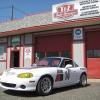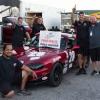Ron,
From what you have described it appears your failures are due to an inadequate supply of oil to the #4 rod bearing. Probably the reason for this lack of oil supply was different in some/each situation. The fact that it is always #4 indicates an oil supply issue as the #4 journal is the furthest from the pump supplied oil coming off the front of the engine.
As you mentioned, the engine operating oil pressure if a function of the system leaks (clearances) downstream of the pump output along with the speed (rpm) of the crankshaft turning the pump. Other than the the oil pressure relief valve, which can only act to bleed off pressure being delivered by the pump as a function of the spring tension behind plunger to hold it on its seat, the only other thing would be the viscosity of the oil being used. This also assumes the oil pump pickup is accessing a constant supply of minimally aerated oil.
Given the above, some reasons that the supply of oil may be in adequate at the #4 rod journal could be as follows;
-Engine oil level is inadequate to allow pump to provide adequate output resulting in aeration.
-Engine oil viscosity is to thin (or oil to hot) for pump to provide adequate output or an adequate oil film to be maintained at rod.
-Engine oil level is not adequate to allow pump to provide adequate output due to lateral forces keeping oil away from pickup tube.
-Engine oil pressure is inadequate to maintain an adequate film of oil between the rod bearing and crank journal.
-Engine bearing wear has increased operating clearances resulting in the operating pressure dropping below required minimum.
-Engine oil is excessively aerated resulting in oil film degradation at rod bearing/journal.
-Engine oil bypass plunger sticking open reducing supply pressure available.
-Engine clearances on average are excessive for the output of the oil pump being used.
-Combination of some of the above occurring.
Since you have not reported any engine failures while on the dyno, yet you have experienced very early bearing failures I would be focusing on how vehicle dynamics might be impacting your bearing life. With your "long life" failures it may just be a case of clearances reaching the point where the oil pressure drops to the point that a failure occurs or it could just be the case of the engine oil level being allowed to get lower than usual resulting in the oil film being inadequate to sustain an adequate oil film.
For the "short life" failures I would be looking at the build clearances, oil pump functionality (did you reuse the oil pump from a previous failure?), bearing quality, rod reconditioning quality.
We experienced rod bearing failures early on in our SM racing endeavors and now closely monitor our engine oil dipstick reading consistently before going out on the track. We make it a point to never go out with the oil level below the full mark on the dipstick. This means we frequently top off the oil level adding two to three ounces of oil at a time as required. I have also found that it is very easy to get a bad reading due to oil in the tube getting transferred to the stick as it is inserted and removed. This can easily result in a false "full" reading I try to always get a cold "full" reading before starting the car each day as that is my reference point for tracking the rate of oil being used under race conditions. Since doing this it has been years since we have had a rod bearing failure with an SM.
Rich Powers




 Sign In
Sign In Create Account
Create Account







 Back to top
Back to top Report
Report





















